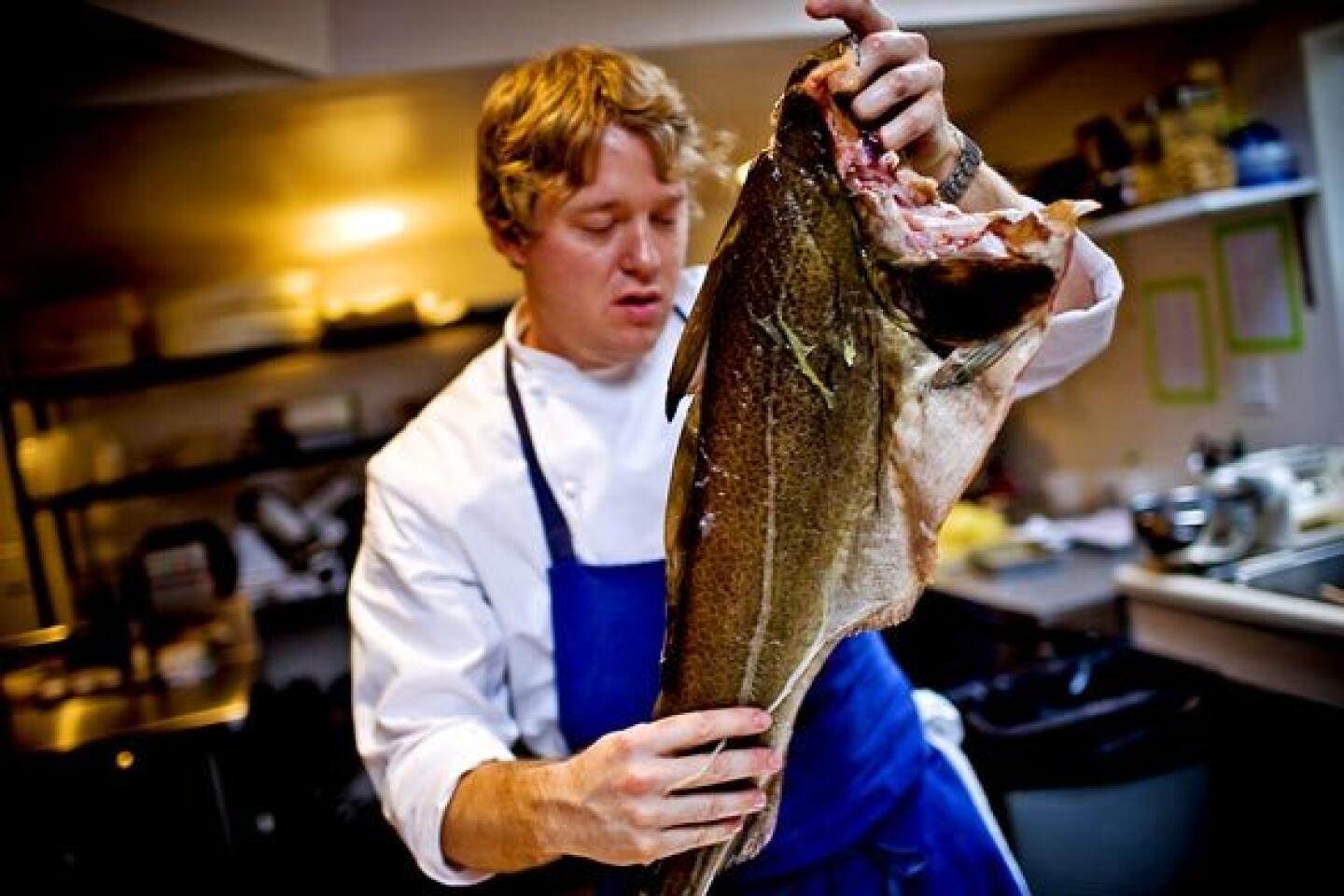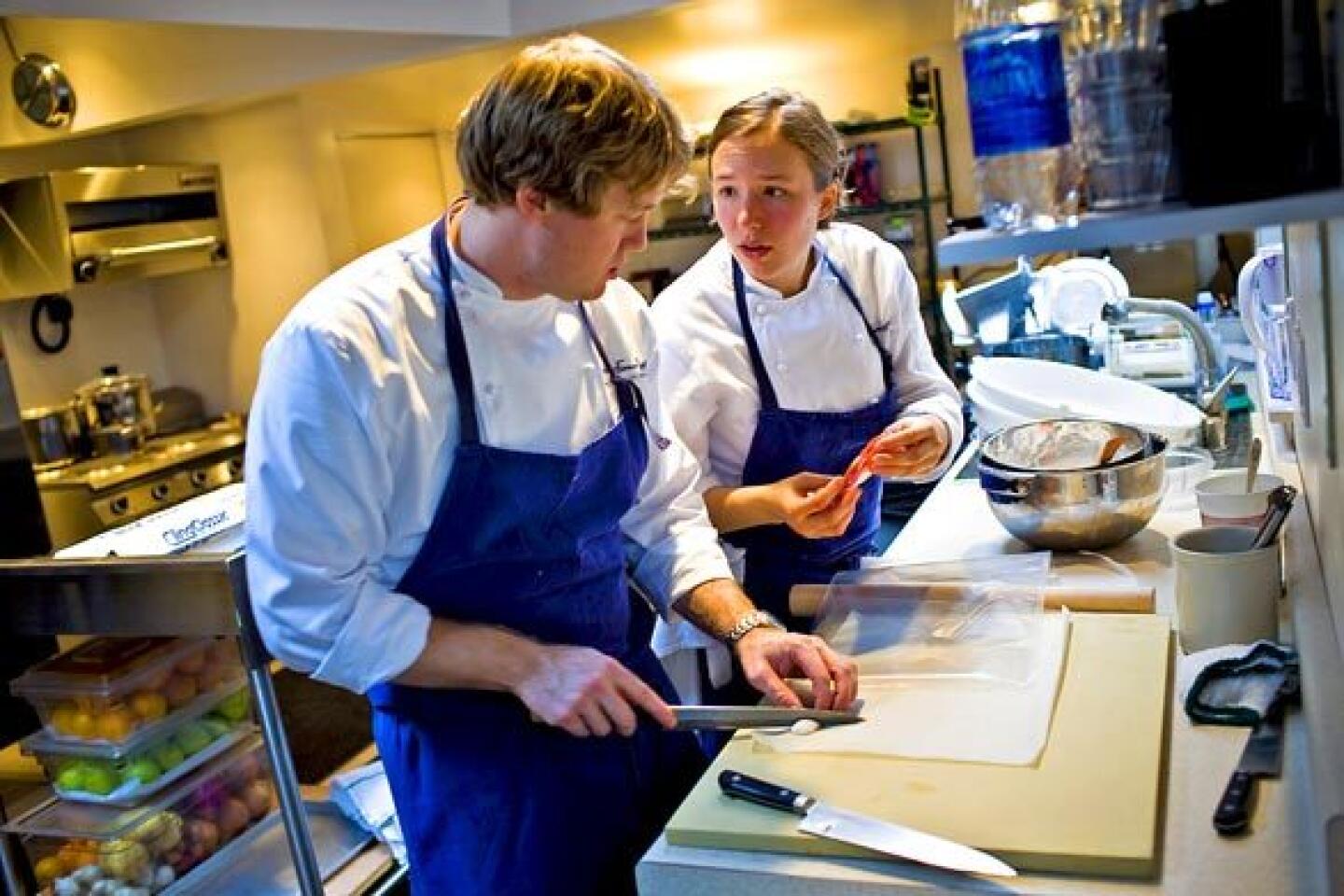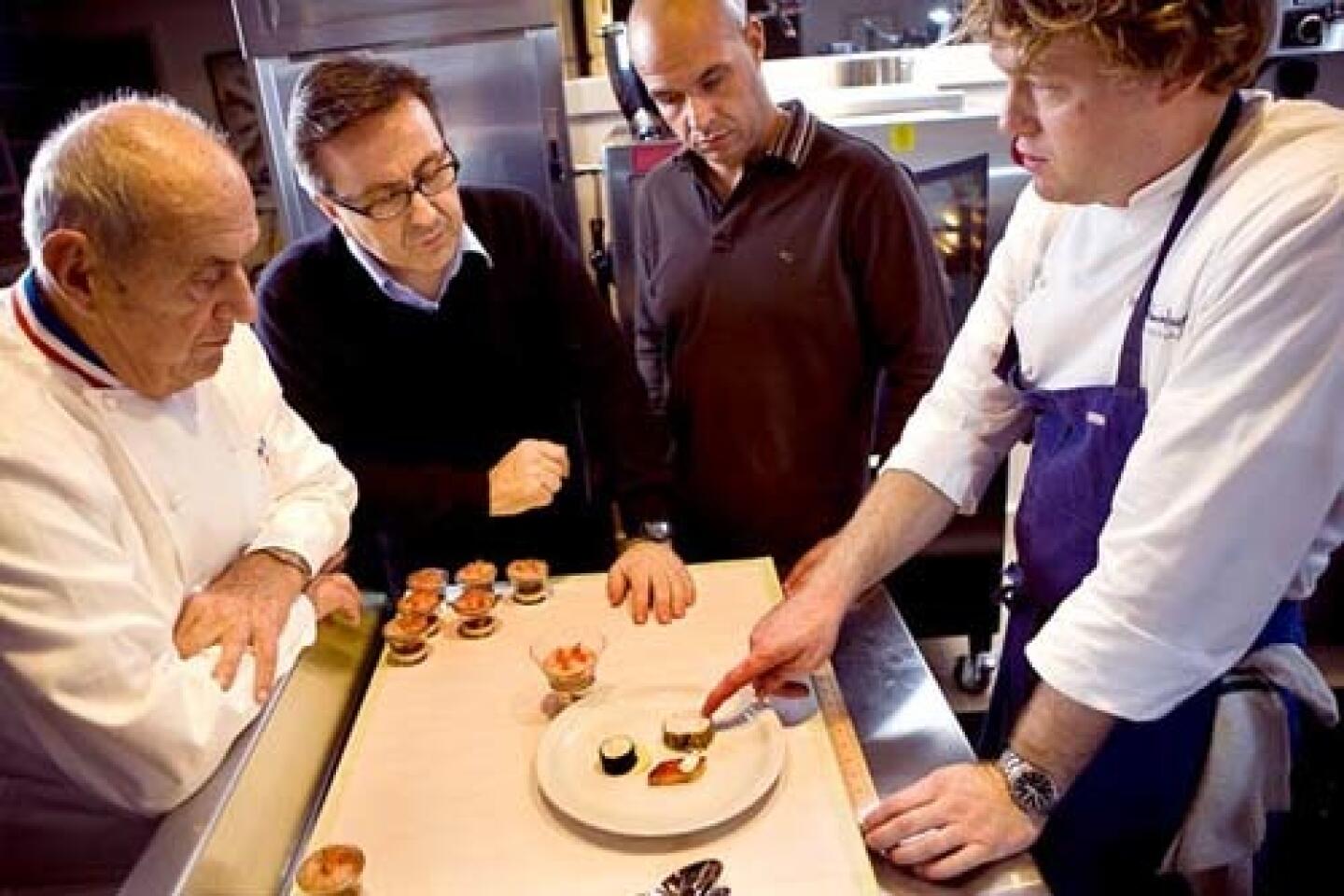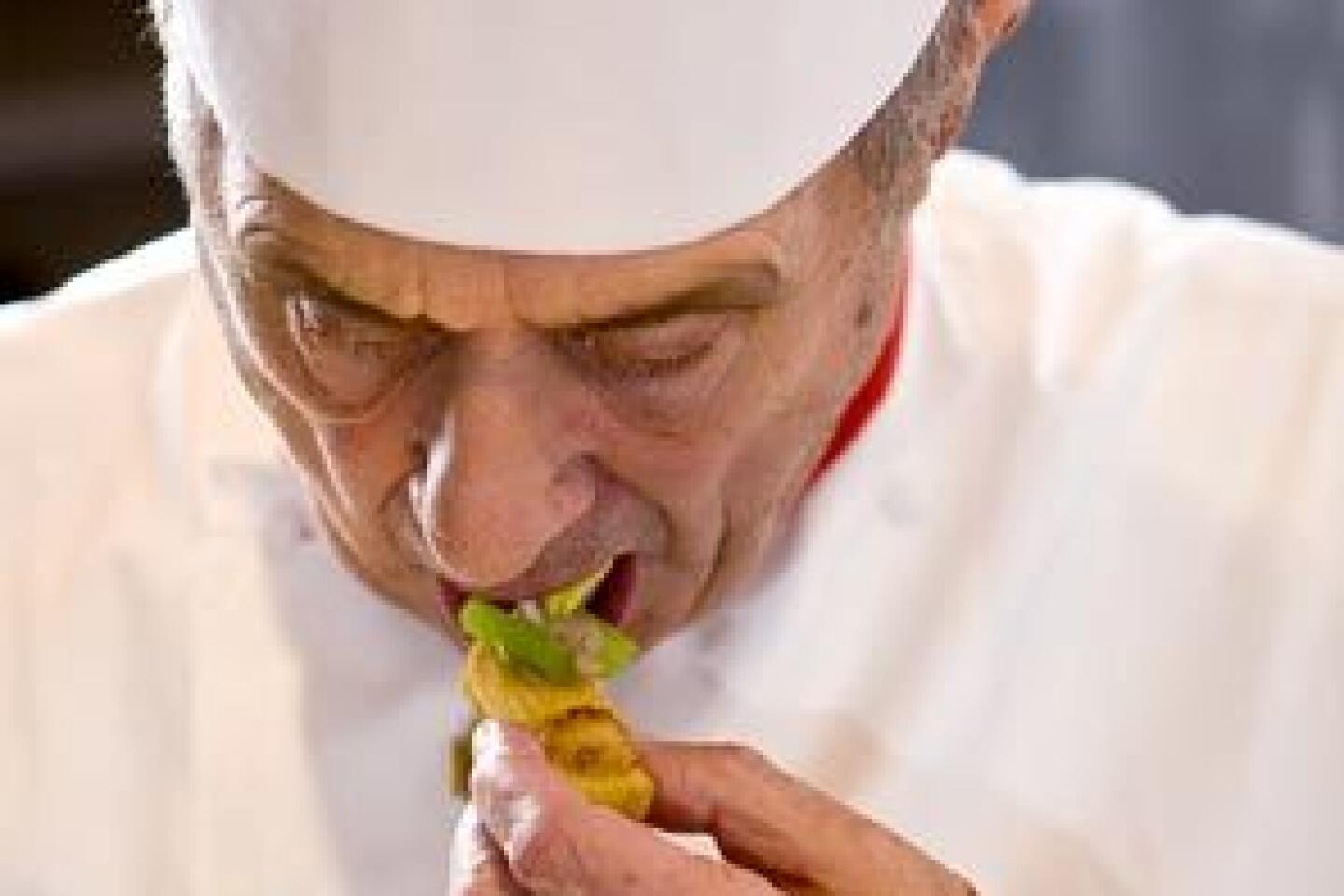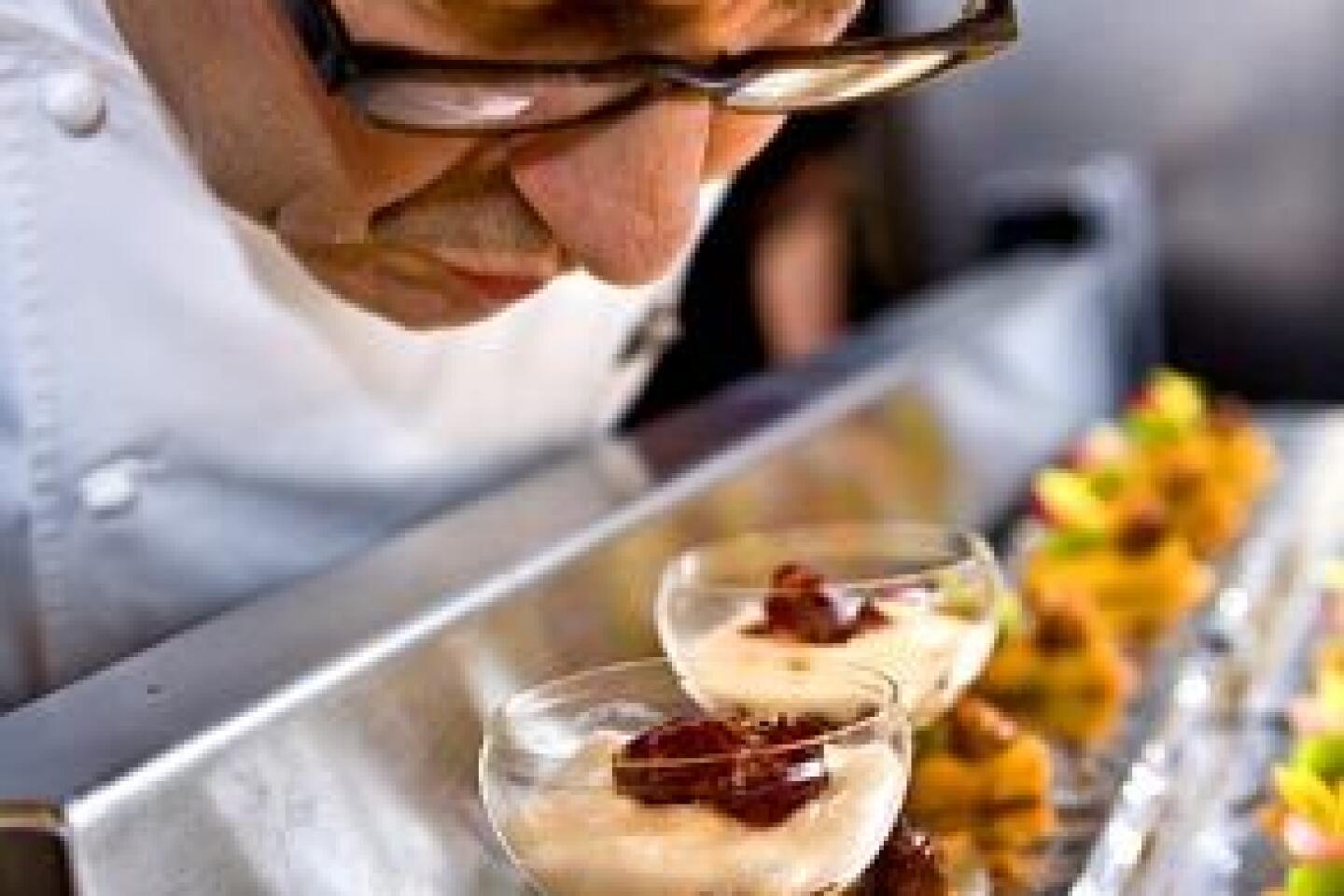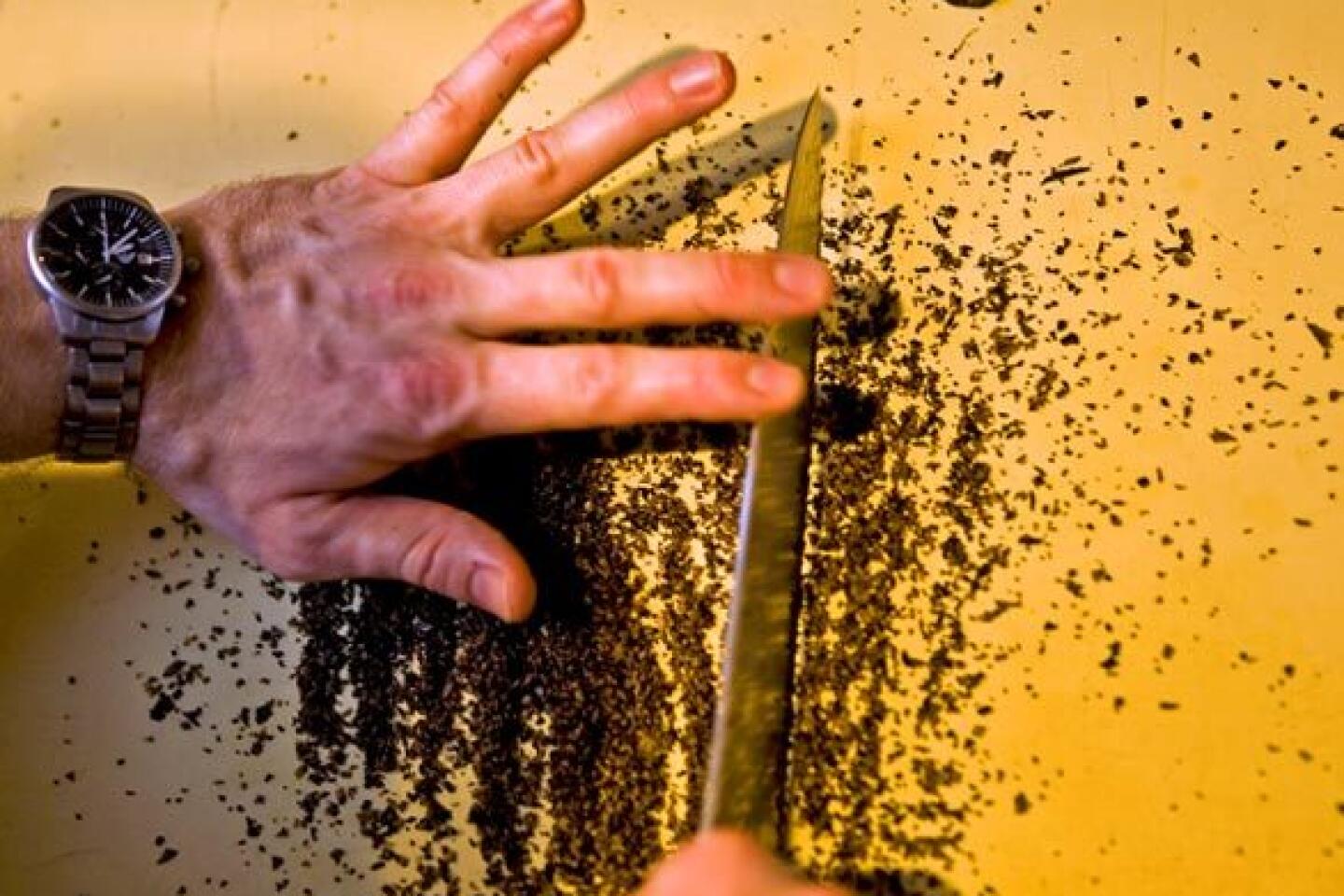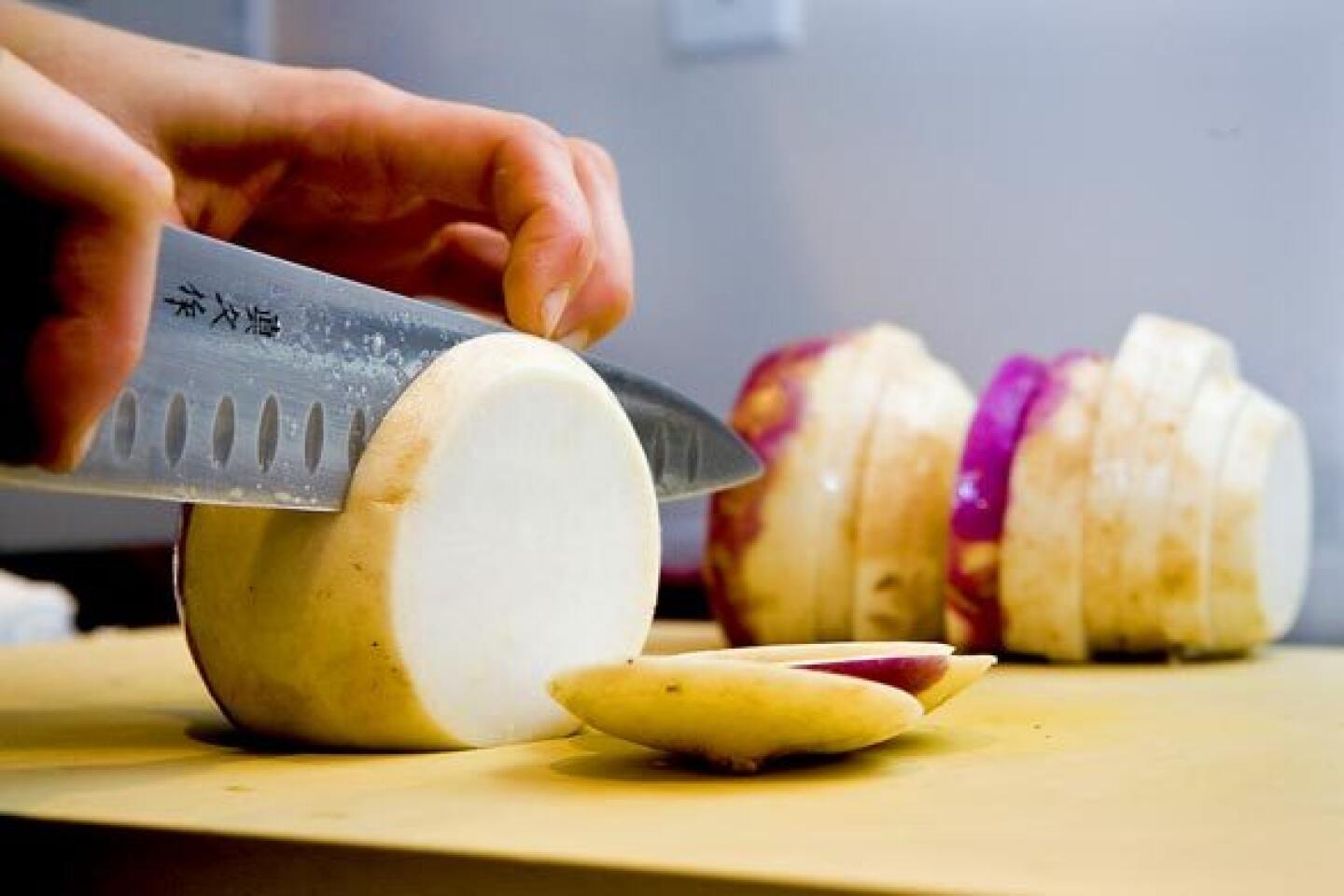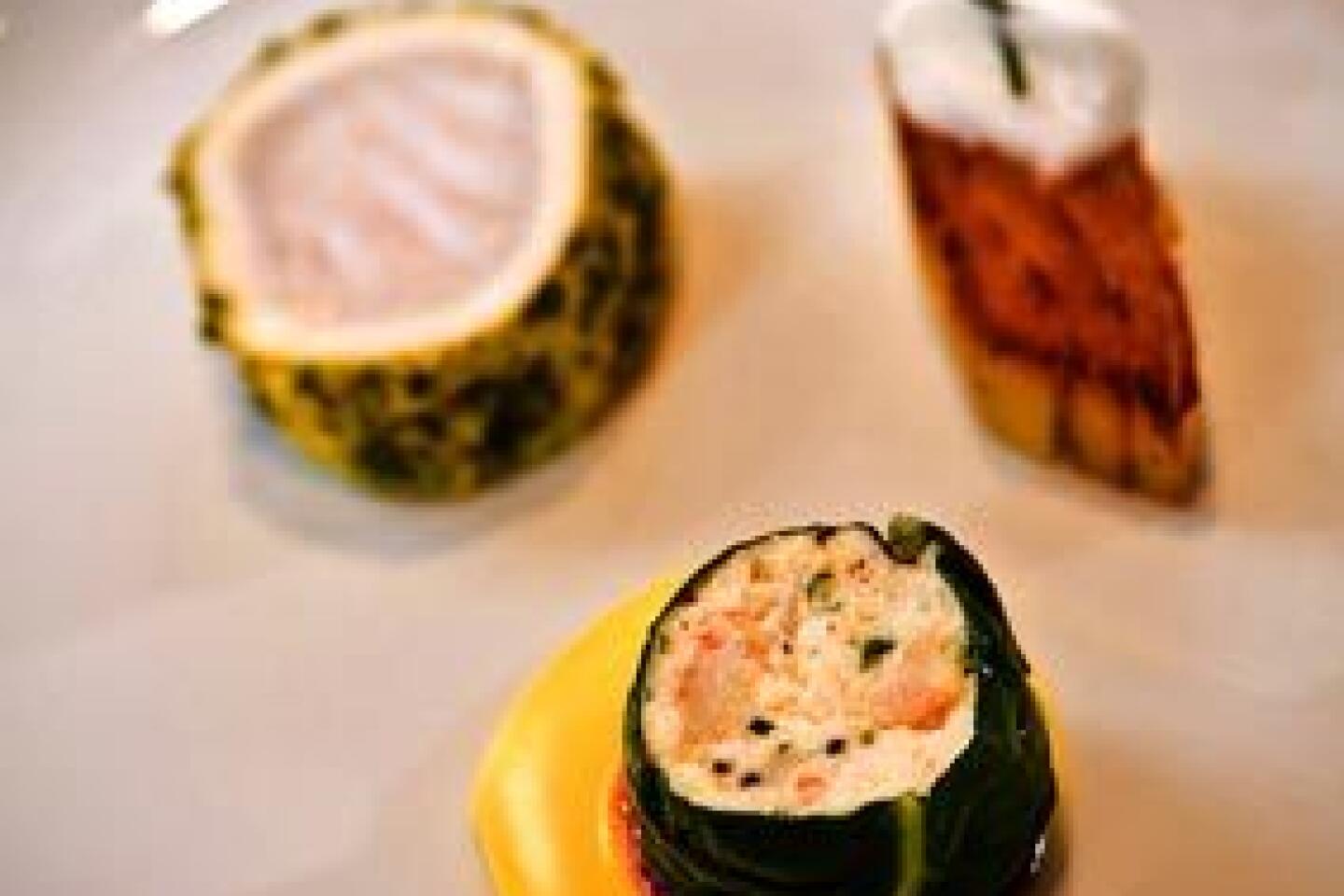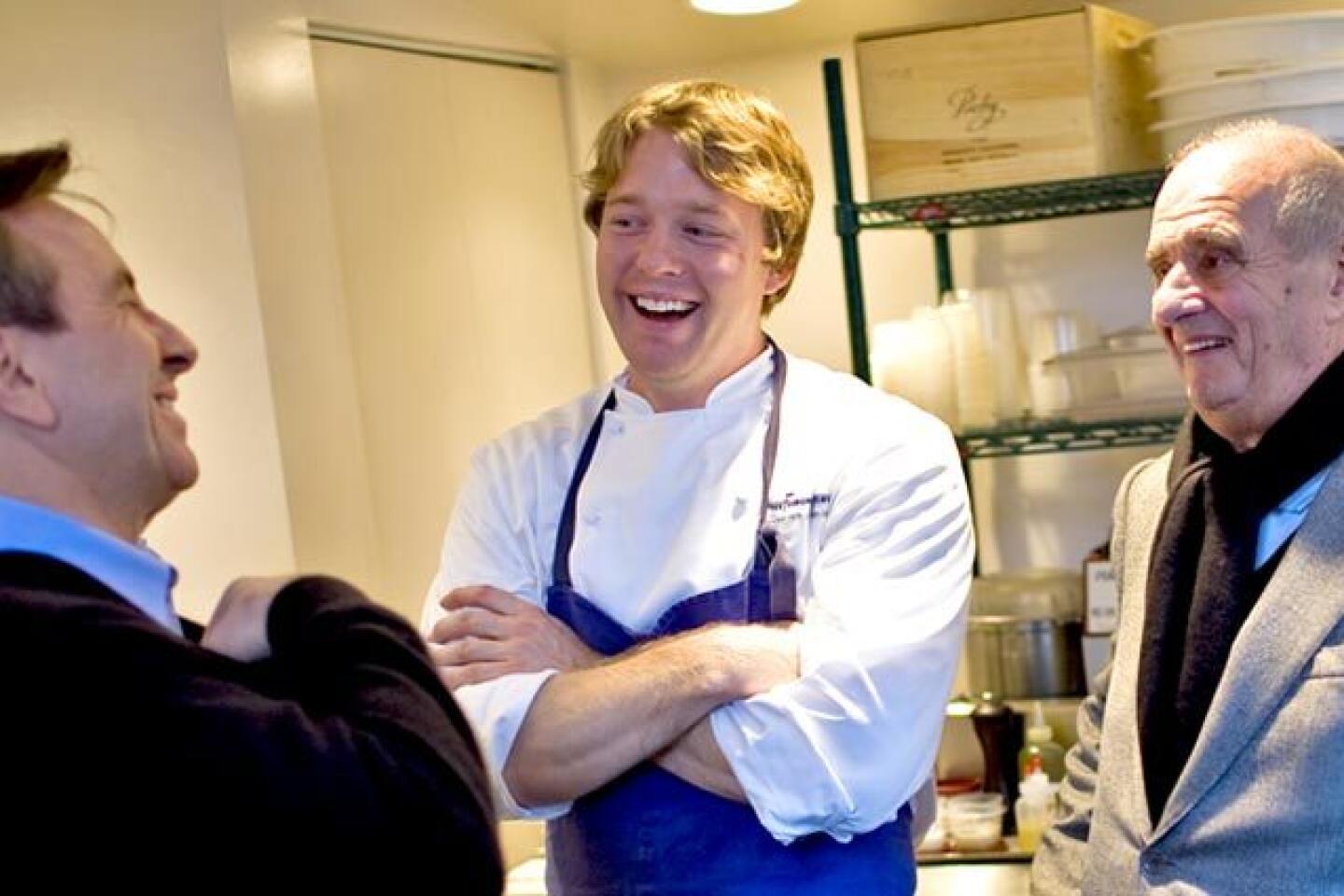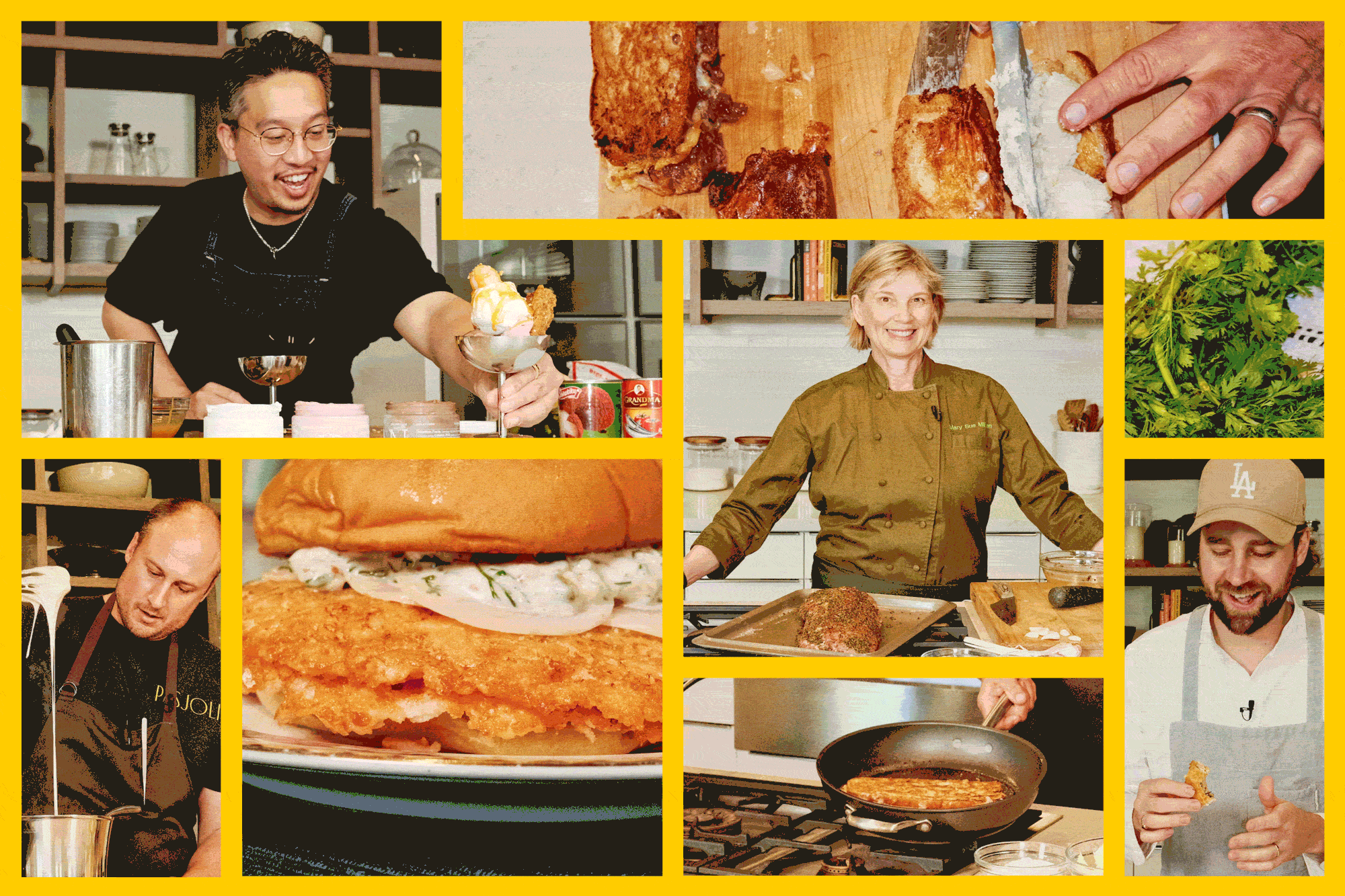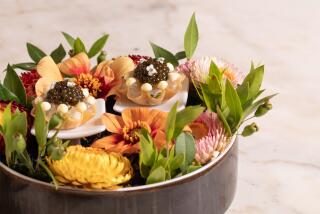American chef preps for cooking fame at France’s Bocuse d’Or
- Share via
Reporting from Yountville, Calif. — On a drizzly day in the heart of Napa Valley, Timothy Hollingsworth stands slightly bowed over his cutting board, crumbling a scallop sausage between his fingers. After months of preparation for the most prestigious cooking competition in the world, and with only a few weeks to go, one of his dishes is falling apart.
What should have been a silken-smooth, perfectly shaped mixture of shellfish and cream has cracked during cooking and is coarse and grainy. As he ponders the problem, his assistant Adina Guest pulls a pastry from the oven. “It’s burned, chef,” she says. As if on cue, smoke fills the kitchen and the fire alarm in the hallway blares. Could things get any worse?
In the middle of this culinary maelstrom, however, Hollingsworth is resolutely calm.
On Wednesday, the unassuming self-taught chef, who through sheer persistence landed a job at the French Laundry, will face screaming crowds, flashing cameras and the opportunity to go where no American has been before: the winner’s podium at the international cooking competition known as the Bocuse d’Or, which takes place every two years in Lyon, France.
Before there was “Top Chef” and “Iron Chef,” there was the Bocuse d’Or. Founded 22 years ago by the legendary Paul Bocuse, regarded by many as the father of modern French cooking, it’s the Olympics of the food world.
This year, after a history of so-so showings, the U.S. is going all-out to elevate its game, with its hopes pinned on the 28-year-old Hollingsworth.
Two of the best chefs in the country -- Daniel Boulud and Hollingsworth’s boss, Thomas Keller -- have put their culinary muscle behind the U.S. team, setting up a training kitchen, providing a paid sabbatical and a coach, and in total raising more than half a million dollars in sponsorships to send Hollingsworth and Guest to Lyon, armed with plenty of truffles and Hobbs’ bacon. “It’s a little bit like Michael Phelps going to Beijing,” Boulud says.
For the last three months, Hollingsworth has been working in the training facility set up next to the French Laundry in the former home of Keller’s late father. The kitchen is laid out much like the 12 stadium kitchens in Lyon, fully equipped open cubicles that face the stands. On a windowsill in the kitchen is Hollingsworth’s trophy -- a statuette of Mickey Mouse -- from the semifinals held in Orlando, Fla., in September, when he beat seven other contestants to represent America in France.
In Lyon, he will have five hours and 35 minutes to prepare eight elaborate dishes on two platters -- using beef tenderloin, côte de boeufcôte de boeuf, beef cheeks and oxtail for one platter, and Norwegian cod, scallops and wild prawns for the other -- for a panel of judges from 24 countries.
“It seems like a long time,” says Roland Henin, Hollingsworth’s coach who has been helping to strategize, “but it’s the shortest time of your life.”
To add even more pressure, on the day of Hollingsworth’s recent practice run the 82-year-old Bocuse shows up. Bundled in a black scarf and tweed jacket, he heads into the kitchen, trailed by chefs Jerome Bocuse (his son) and Boulud -- both executives of the U.S. committee for the Bocuse d’Or. Jerome Bocuse is chef at Epcot’s Les Chefs de France and Boulud owns top restaurants such as Daniel and Cafe Boulud in New York.
Paul Bocuse holds up two fingers and says definitively, “Deux bons plats.”
Boulud translates this fundamental piece of advice: “Two good platters. To win, you cannot have one very good and one not so good.”
In five hours the chefs must prepare everything from scratch, including breaking down a whole cod and butchering a 9-pound rib roast. Going under the microscopic scrutiny of these judges, Hollingsworth and Guest must make every cut on every dish with surgical precision.
“Our first full run for Orlando we were four or five hours over,” Hollingsworth says. “But we’ve been making good time; we’ve even had time to wash dishes.”
Since early October, he has been in the training kitchen 40 to 50 hours a week, experimenting with different dishes and combinations, scrapping them when they didn’t work, then going in a new direction.
Despite having hammered out dishes nearly every day, and even with the competition so near, at this point Hollingsworth has prepared the full menu only twice.
History isn’t on Hollingsworth’s side. Until 1999, France won every year that it competed. (The winner takes home the golden Bocuse trophy and about $26,000 in euros.) For the last decade, Norway has proved an upstart rival.
“Look at the winners,” says Hartmut Handke, the highest-ranking former U.S. contestant, who placed sixth in 2005. “France and Norway, Norway and France. It’s going to be extremely hard to break into this monopoly.”
Hollingsworth grew up in Placerville, Calif. He started cooking in high school and worked at a restaurant called Zachary Jacques, whose then-owner Hollingsworth credits for turning him on to a chef’s career. When he wasn’t braving the surf at Bolinas or Ocean Beach, he was reading every cookbook he could get his hands on. After reading Keller’s “The French Laundry Cookbook,” he was inspired to apply for a job.
He handed in his resume at the French Laundry one night after eating dinner there with friends. Keller “said I could stage [intern] for one day,” Hollingsworth says. “After that I kept calling.” He has worked there for seven years.
At a time when it seems like every young chef has graduated from culinary school camera-ready, Hollingsworth is a throwback. He never attended culinary school and worked his way up through the ranks of the kitchen brigade.
When French Laundry chef de cuisine Corey Lee approached him last summer to consider vying for a spot at the Bocuse d’Or, he declined.
“It came up again in a managers meeting and Thomas [Keller] was there,” Hollingsworth says. “He asked, ‘Does anybody want to do the Bocuse d’Or?’ Everybody was ‘no, no, no.’ He said it would be cool if someone [from the French Laundry] did it, and they were all kind of looking at me. . . . So I said, ‘OK, I’ll do it.’ ”
Hollingsworth is inherently competitive and a natural cook, Lee says. “I think there are natural cooks and those who have to work harder to execute the same quality.”
Hollingsworth chose Guest as his assistant, a 22-year-old commis (apprentice) who had just started at the restaurant a few months before. “I watched her work,” Hollingsworth says, “and was impressed by her level of intensity, her execution.”
In the training kitchen, Hollingsworth and Guest work precisely and quickly. When Paul Bocuse sees Guest deftly slicing potatoes and black truffles (Oregon truffles for the practice runs) for the pommes dauphinoise that go on the fish platter, he gives a thumbs-up and says “trés bonne la fille.”
Hollingsworth chops truffles with his knife to nearly a fine powder and slices beef tenderloin into almost paper-thin coins. The kitchen smells like roasting beef and herbs simmering in cream.
Neatly taped to the four-door freezer are the menu and two schedules -- one for each chef -- broken down into 15-minute increments. For example, at 0:00, Hollingsworth’s schedule says “break down beef x4, braise in oven, oxtail, start cod” and Guest’s schedule says “stock on with oven hot, boiling water.” Their respective schedules continue until 5:00 when they plate the seafood and 5:35 when they plate the beef.
Three hours into the practice run, Hollingsworth and Guest are 20 minutes behind. Still, Hollingsworth is unflappable.
“I don’t think they know panic,” says Andrew Friedman, who is writing a book about this year’s Bocuse d’Or, tentatively titled “Knives at Dawn.” “You should have seen them in Orlando. Nothing was ever out that didn’t need to be out. It always looked like they had just started cooking.”
The kitchen of another competitor, Friedman says, “looked as if a bomb went off.”
This is cooking at its highest level. The objective is to represent the cuisine of one’s own country, but the tacit expectation is to demonstrate French technique. The competition dishes are often very technically complicated, involving a lot of layers -- say, carrots rolled in leeks rolled in chicken mousse rolled in deboned oxtail. Molded dishes have been popular, such as a fish mousse in the shape of a fish.
“I hope to bring a more modern approach to it,” Hollingsworth says, “something fresher and lighter and not as contrived or extremely manipulated.”
The food will be presented on custom-made platters that can cost several thousands of dollars apiece. Architect-designer Adam Tihany was enlisted to design Hollingsworth’s platters, and in what might be a Bocuse d’Or first, the tiered platter for the beef will have recessed lights.
None of this could have been possible for previous American competitors. Sabbaticals and substantial sponsorship for Bocuse d’Or competitors have long been in place in Europe. In the past, chefs from the U.S. have had to train on their own time and raise funds themselves.
Handke, who was 63 when he competed, trained at the restaurant he owned in Columbus, Ohio.
“Every other night we did a full-blown practice session after our shifts, starting at 11 p.m. and working until 4:30 in the morning, get a couple hours of sleep and then go back to work,” he says.
Back at the training center, Hollingsworth and Guest have finished their platters under time, despite the day’s glitches. He takes the scallop boudin and throws it in the trash. “I don’t want anybody to taste this,” he says. The beef platter is closer to being nailed, but, he says, “everything needs more work, every dish needs tweaking.”
The suggestions start flying: The beef tart could be smaller to better balance the platter; the pistachios could be dried and ground in stages to get a finer powder; the beef cheeks could be cut with a puncher for a more perfect shape.
Maybe cook the chestnuts more, maybe ease up on the hand-held smoker, maybe put some horseradish into a cheesecloth and squeeze just five drops of the juice into the foam. . . .
While the chefs continue to discuss, Paul Bocuse retires to the living room. He has removed his chef whites and toque, which he had put on later in the afternoon, and settles into the brown leather sofa. He seems less concerned with the details than the big picture.
“It’s not hard to win,” he says, repeating what he has probably told many competitors. “Good product, good seasoning, the exactly right amount of cooking. C’est tout.”
More to Read
Go beyond the scoreboard
Get the latest on L.A.'s teams in the daily Sports Report newsletter.
You may occasionally receive promotional content from the Los Angeles Times.
